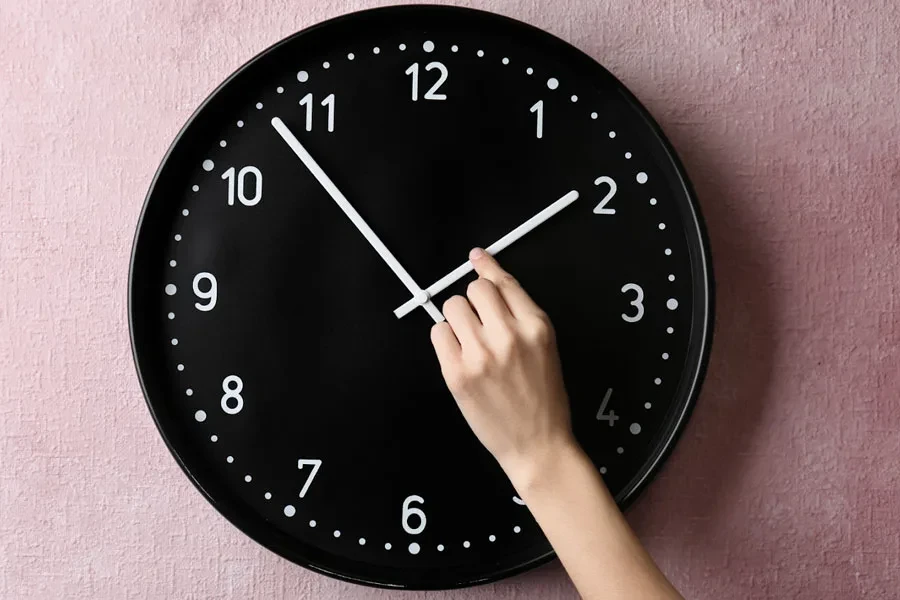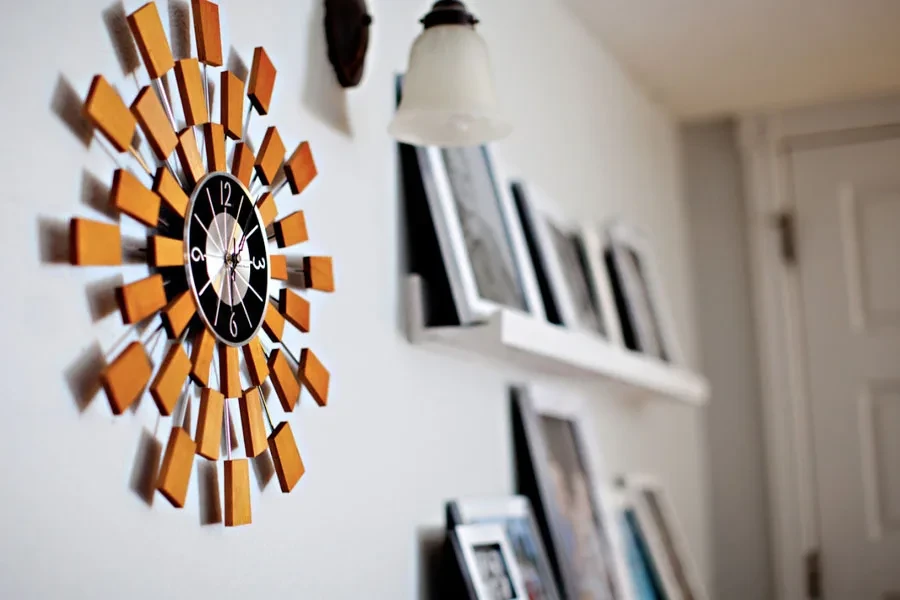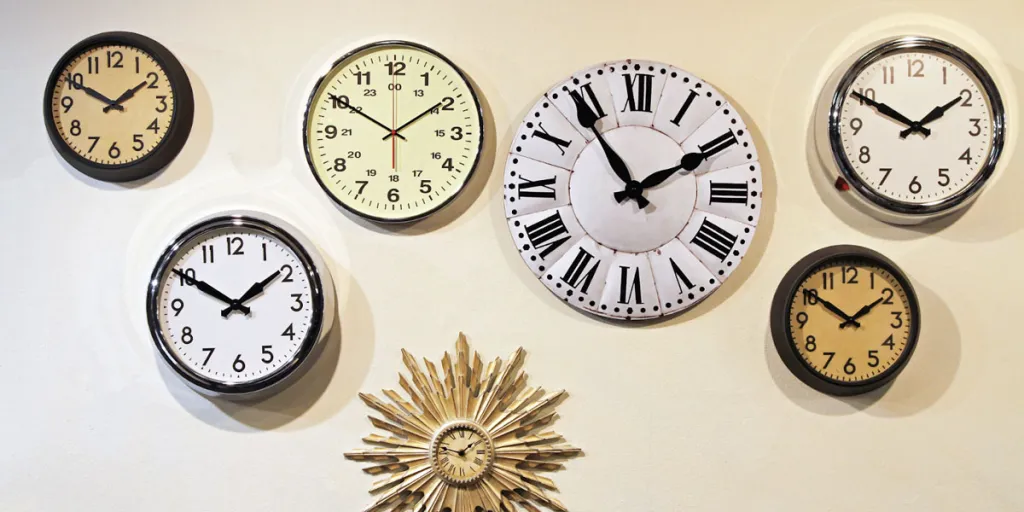Aside from helping users to tell the time or meet schedules, wall clocks add a touch of style to home or office decor. And despite the rise of phones and other digital technology with in-built time-keeping functions, there’s still a wall clock for almost everyone out there.
Here, we’ll cover several factors to consider when choosing the right designs for your shop, including an overview of various available styles available as well as a look at the global market as it stands.
Table of Contents
Are wall clocks still trending in this digital age?
Factors to consider when selecting wall clocks
Conclusion
Are wall clocks still trending in this digital age?

While wall clocks might not be as popular as they once were, they still hold significant value in modern homes; the digital age may have made it easy to tell the time, but it can’t beat the beauty and statement-making design of wall clocks.
According to Google Ads, demand for wall clocks remains high, with them receiving 368,000 searches in March 2024.
With these points in mind, let’s take a look at several other reasons why wall clocks are still trending today:
1. Functionality
At their heart, wall clocks still serve the fundamental purpose of telling time. In a world where digital screens constantly surround us, wall clocks offer a tangible, dedicated time display, which has helped them maintain a market presence. As we become increasingly reliant on phones for timekeeping, wall clocks offer a breath of fresh air, resulting in less distraction and the cultivation of a less technology-saturated space.
2. Design
Phones may be great, but despite being very functional, they can’t beat the classy aesthetics of a wall clock. Wall clocks today come in a huge range of beautifully designed styles, helping to keep them relevant in today’s digital age. They often come in various materials, shapes, colors, and mechanisms, helping them to blend in with interiors without feeling out of place. And the sheer variety of designs (minimalist, contemporary, rustic, vintage, abstract) ensures that there’s a wall clock out there ready to complement any decor style.
3. Practical advantages
Wall clocks also offer numerous practical advantages. For starters, they are easy to read from a distance, especially those with large numerals and contrasting colors. This practicality is beneficial in certain spaces like kitchens, offices, or living rooms. In addition, analog wall clocks function independently during power outages, making them reliable timekeepers, unlike digital devices.
Factors to consider when selecting wall clocks

Size and weight
The perfect wall clock should align with the target consumer’s desired aesthetic and functionality. If they prefer a subtle addition to their decor, they will opt for smaller clocks, typically around 10 inches. However, if they want to make a bold statement, they may consider larger sizes up to 30 inches. Wall clocks typically fall within this range, offering various options for different preferences and spaces – see the table below for more size information:
| Wall clock size | Weight range | Perfect use |
| Small (6 to 12 inches diameter or 15 to 30 centimeters) | Under 2 pounds | Used for compact spaces (bedrooms and kitchens) or as decorative accents |
| Medium (12 to 24 inches diameter or 30 to 61 centimeters) | 2 to 5 pounds | More versatile and look great in various rooms, including dining and living rooms |
| Large (24 to 36 inches or 61 to 91 centimeters) | 5 to 10 pounds | More popular as statement pieces, making them great focal points |
| Oversized (larger than 36 inches) | More than 10 pounds, depending on materials and design | Make dramatic visual impacts, often used in spacious areas |
Materials

Wall clocks also come in different materials – mostly plastic, wood, and metal – giving each one a different vibe. Materials also determine durability and quality, so consider how this may affect reputation down the road.
Plastic
When it comes to wall clock materials, plastic is the most economical option, making it budget-friendly for many. While thinner plastic clocks are the most affordable, thicker variants may have slightly higher price tags. Regardless, plastic clocks offer versatility in color, allowing them to blend seamlessly with various interior design styles.
However, sellers should note that plastic clocks typically have a shorter lifespan than other materials. Nevertheless, their affordability and adaptability make them a popular choice for those seeking a cost-effective timekeeping solution that complements many types of decor.
Wood
Wooden wall clocks add a charming touch to rustic and farmhouse-style settings, enhancing the cozy ambiance of any living space. The best part is these wall clocks are available in various wood types, including common pine, eucalyptus, and even luxurious mahogany (for a more refined appearance). Their timeless appeal and natural warmth remain a top favorite, especially among consumers who prefer classic elegance and rustic charm.
Metal
Metal wall clocks are sleek and modern, making them an excellent choice for minimalist and industrial-themed spaces. Their blend of stylish and sophisticated helps these clocks effortlessly blend into contemporary environments.
Shape and style
Shape and style are critical to which type of wall clocks a consumer is likely to choose. Like size, shape and style determine if a wall clock will complement the target consumer’s room design without overpowering it. Check the table below for a description of which wall clocks suit different styles.
| Wall clock shapes and styles | Suitable use |
| Round clocks | A classic and versatile clock shape, round clocks look and feel natural in different environments, whether they’re contemporary, traditional, or transitional |
| Square and rectangular clocks | These shapes may not be very versatile, but they offer eye-catching modern and geometric looks. They’re particularly suited to minimalist and contemporary decor, as squares and rectangles make rooms feel more structured and balanced. |
| Unique and abstract shapes | Wall clocks featuring artistic and unconventional shapes, such as those with abstract or irregular designs, fall under this category. These wall clocks tend to place more emphasis on aesthetics and statement-making over easy time reading. |
| Industrial-style clocks | These wall clock styles come packed with industrial and steampunk-inspired aesthetics, like metal frames, exposed gears, and rugged appearances. Industrial wall clocks are perfect for adding unique and edgy elements to any space. |
| Nautical and coastal clocks | These styles have different maritime elements, like anchors, ship wheels, and ocean-inspired colors, making them popular for beach or coastal-themed decor |
Mechanisms
While the wall clock market offers incredible variety in terms of design, these clocks predominantly use two key mechanisms: quartz or mechanical, significantly influencing accuracy, maintenance, and features.
Quartz mechanisms currently dominate the wall clock landscape and come in two major versions: silent or tick-tock and high-torque or low-torque variants. Typically, larger wall clocks exceeding 35 inches use high-torque mechanisms to ensure proper and accurate performance.
In contrast, mechanical wall clocks tend toward more premium craftsmanship to maintain accuracy. Since mechanical wall clocks are not as flexible as their quartz cousins, opting for low-quality versions may cause considerable frustration regarding time-keeping in the long run.
Conclusion
We may very well be living in a digital age, but wall clocks have maintained their status as a timeless trend. These products help breathe fresh air into technology-packed homes thanks to their aesthetic appeal.
For more design and housekeeping tips, make sure to subscribe to Chovm.com Read’s home and garden insights section.





 বাংলা
বাংলা Nederlands
Nederlands English
English Français
Français Deutsch
Deutsch हिन्दी
हिन्दी Bahasa Indonesia
Bahasa Indonesia Italiano
Italiano 日本語
日本語 한국어
한국어 Bahasa Melayu
Bahasa Melayu മലയാളം
മലയാളം پښتو
پښتو فارسی
فارسی Polski
Polski Português
Português Русский
Русский Español
Español Kiswahili
Kiswahili ไทย
ไทย Türkçe
Türkçe اردو
اردو Tiếng Việt
Tiếng Việt isiXhosa
isiXhosa Zulu
Zulu